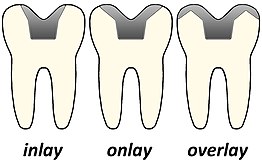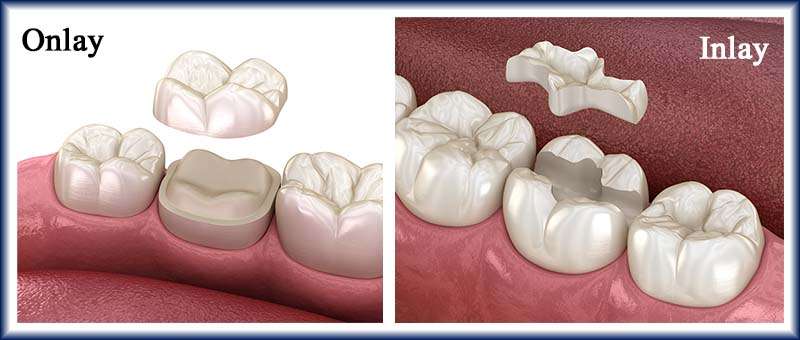Composite/Porcelain Inlay or Onlay
Composite/Porcelain Inlay or Onlay
Inlays and onlays are an indirect restoration or filling used when the teeth are too damaged to be repaired by normal dental fillings, but not damaged enough to require a dental crown. The other type of ‘white filling’ is called a Composite or Porcelain Inlay.


Some FACTS about composite/porcelain inlays and onlays:
- Secret Strength: Inlays and onlays are stronger than fillings because they’re custom-made in a lab, giving your chompers extra reinforcement!
- Chameleon Fillings: Composite inlays and onlays can be color-matched to perfectly blend in with your surrounding teeth, making them practically invisible!
- Saving the Tooth Team: Inlays and onlays are minimally invasive compared to crowns, which means they preserve more of your natural tooth structure. It’s a win-win for a strong and beautiful smile!
A little breif
They are constructed before hand- outside the mouth with a special tooth coloured material such as ceramic or porcelain, to fit a specifically sized and shaped cavity.
Once the filling has been constructed, it is then cemented to the inside or outside of the tooth. This is a two-visit procedure rather than the 0ne visit required to place a composite filling. However, when it comes to strength and cosmetics, the extra time and expense is well worth it!
An inlay is made to fit inside the tooth whereas, in contrast, an onlay is made to fit inside the tooth but extends outside to the surface area of the tooth.
Both inlays and onlays are being constructed of tooth coloured material to preserve the natural aesthetic appearance of the tooth. In fact, by restoring a troubled tooth with an inlay or onlay, you might decrease the need for a crown later on.
FAQs!
Inlay vs. Onlay: What's the Difference?
Inlays are restorations placed within the cusp (pointed area) of the tooth. Imagine it like a filling that fits perfectly into a groove. Onlays cover a larger portion of the tooth structure, extending over one or more cusps. Think of it like a partial crown that fills a more substantial cavity.
Composite vs. Porcelain: Which Material Should I Choose?
Aesthetics vs. Durability:
- Composite: Made from tooth-colored resin, composite inlays and onlays blend seamlessly with your surrounding teeth, making them a great choice for teeth visible when you smile. However, they may chip or wear down over time and require replacement sooner than porcelain.
- Porcelain: Highly durable and stain-resistant, porcelain inlays and onlays are ideal for back teeth that endure more chewing force. They tend to last longer than composite but may not perfectly match the shade of your natural teeth.
How Long Do Inlays and Onlays Last?
Brush, Floss, Smile! With proper care (brushing, flossing, and regular dental visits), inlays and onlays can last for many years, often exceeding 10 years. Maintaining good oral hygiene and avoiding excessive biting force on hard objects will help ensure the longevity of your restoration.
